In May 2005 we planned a dive session during 5 days in the Southern part of France. The Dives were made by 5 Dutch Inspiration divers, and one Inspiration/ Kiss diver. Members of the team where: Ivo van Dam, Tino de Rijk, Rita Oosterbaan, Arjan van Waardenburg, Rob Postma and Janwillem Bech (author). All dives are made with the very experienced and friendly crew of Bormes Plongees. Check out there website here: http://www.nauticadive.com/index.htm . During the night we stayed on a very nice camping called: Camping Manjastre. We had a very nice week with excellent weather. Only the first day there was to much wind for diving “la Grec” so we decided to go to the Gabiniere reef. The rest of the week the weather was on our side and winds stayed out. We were lucky enough to meet a group of Dolphins on the surface and a Mola Mola, also called Moonfish. The dives were fantastic and visibility was good. We mixed our own gas on the camping site. The owner of the camping is an Inspiration diver too, so no problems with mixing gas and cleaning our diving gear.

Planning: We planned dives in the range 40 – 70 mtrs. We decided to choose a trimix 13/38 to keep the preparations simple. Even with this preparation it costs a lot of time to get all bottles prepared and analysed. The END has been set to 40 meters. For the dives up to 50 meter bailout bottom gas was TX13/38 and the deco mix OC EAN 40. (7ltrs bailout). For the deeper dives bottom gas TX 13/38 and deco gas EAN 70 (10ltrs bailout). Because we planned a dive to 85 meters too we accepted a higher END in case of bailout.
All divers except 1 used VR3 decompression computers. The other diver used a HS explorer computer. Bailout tables were generated with DD plan, GAP and proplanner.
We used a brother label printer to print our bailout tables on plastic foil, which worked superb.
No problems occurred during all 5 diving days, and we can look back at a very nice diving adventure!
Max diving time 112 min, max diving depth 82,5 meters (270 ft). No bailout gasses were needed because no failures occurred.
Dive preparation
The first photo series shows the preparations we carried out every day at the campsite and in the harbour. The aim of our diving trip was to blend our gases and fill our cylinders completely autonomously. For this purpose, we had brought several gas cylinders and had our own compressor. The owner of the campsite was very helpful to us because he dives with rebreathers himself. Filling and planning our dives took quite a bit of the day, but it was a good exercise to get the hang of blending and planning.
Day 1 Isle de la Gabiniere
The first day we dived this fantastic Island group because there was too much wind for the dive that was planned. The Gabiniere island is situated in such way that even when strong winds occur dives can be made here.
Technical data of the dive made by Janwillem Bech en Ivo van Dam:
Maximum depth: 49 meters
Duration: 85 minutes
Diluent: Tx 13/38
Bailout: Tx 13/38 and EAN 40 (7 liters)
Day 2 Le Donateur (MS Prosper Schiaffino)
One of the most beautiful dives we made on the Donator. The ship lays in 48 meter of water. Here is a small historical review:
The Prosper Schiaffino better known the Donator was a freighter. She had a length of 78.30m, 12.0m at the beam and a draught of 5.54m. She was powered by engines developing 1800hp giving her a maximum speed of 14 to 15 knots. Her crew was made of 30 men.
She was built in 1931 at Bergen Mak Verksted A/S shipyard in Norway and launched under the name Donator as an Italian freighter. In October 1933 she is sold to the Compagnie Générale Armament Maritime and becomes a banana freighter known as Petite Terre. In 1939, she is purchased by the Compagnie Algérienne de Navigation (Schiaffino Cie) and renamed Prosper Schiaffino. On the 11th of October 1945, she leaves Marseille with a cargo of vegetables heading for Alger. There she unloads and goes back to sea with a cargo of barrels and on deck tanks of wine. Taking cover of the Mistral (northern wind) she heads for Spain following the coast. Near the Islands of Porquerolles she meat a minefield was not yet disarmed. The explosion emerged on the 10th of November 1945 and nearly ripped off the bow. 11 of the 30 crew where recovered by a fighter 111.
Maximum depth: 48 meters
Duration: 85 minutes
Diluent: Tx 13/38
Bailout: Tx 13/38 and EAN 40 (7 liters)
Bottom time: 40 minutes
Day 3 MS Sagona or ‘le Grec’
“Le Grec” or Sagona was planned to be our first dive. Due to the weather we could dive her only after two days. The wreck was very nice and offered great diving. During the decompression we encountered unknown species (See biology further in this post). These animals where unbelievable and I am working to find more information about them.
The Sagona was a small freighter of 53.30m in length and 8.60m at the beam.
The Sagona was built in 1912 in Dundee and passes from company to company : Newfoundland Produce then Reid Newfoundland, l’Etat, Culiford Associated Lines and finally in 1943 she is purchased by Zarati and flags her as a Panamanian vessel. The Sagona known as le Grec because the crew and papers where Greek at the time of wreck on the 3rd of December 1945. Loaded with wine, she cruise to close to the coast and enters a dangerous area known as la Grande Passe. A forgotten mine blows up the port side bow and sinks the vessel immediately. Two casualties and one lost crew member. The violence of the explosion cute the freighter in half, destroying the deck and the superstructures.
Site : she lies 600m east of the Petit Sarranier.
Coordinates : 42 deg 59,68 north / 06 deg 16,89 east.
Depth : from 35m at the funnel and 48m at the stern.
Technical divingdata:
Maximum depth: 46 mtrs
Diving time: 79 minutes
Gas: Tx 13/38
Bailout: Nitrox 40
Day 4 Le Trafic
Le Trafic
On the fourth day we made a trip to a deeper wreck called “Le Trafic”. The ship has only recently been discovered (2003?) and lays in 60 meters of water. There is not much known about this little ship. We were told that 50 – 100 meters from the bow in western direction there seem to be a drop-off to very great depths. Ivo and me decided to follow this direction and try to find this abyss. The only thing we found was an empty reel (200 mtr) and a lot of sand @ 82 meters. We decided to return to the wreck. I only managed to make some front pictures of the boat because no bottom time was left…
Rebreather dive using TX 13/38 as diluent.
Bailout gas TX 13/38, 10 litres, Deco gas EAN 70 10 ltr.
Dive time 101 minutes, max depth 82,5 meters (270 ft)
Day 5 Le Togo or Ville de Valence
The Last day we made a dive on the Togo. We all had nice memories about this wreck. I dived it in 2003, and remembered the beauty of al gorgons and the huge quantity of fish and troupers. Unfortunately visibility was not so good as earlier days, but after all we made a 112 minute dive!
The “Togo” before “Ville de Valence”
The Togo was a steamer of 1484 tonnes for a length of 78.5m, 10.5m at the beam. Her motorization developed 208hp and was equipped with three masts. The crew was made up of 22 to 28 men.
Launched on the 30th of August 1882 by the shipyard “Robert Thomson”, under the name of “Ville de Valence”, the cargo belonged to the “Compagnie Havraise Peninsulaire” and was intended to cruise to Spain. By 1905-1906 she was sold to “Becchi & Calagno”, an Italian Cie from Savone and renamed “Amor”. In 1911-1912, she is sold to “Ilva”, a Cie from Gênes and renamed “Togo”. She struggled through the 1st World War as a fruiterer and later as a coaler until it’s shipwreck on the 12th of Mai 1918. The loss of the Togo was the job of a German U-boat UC 35 registered in Austria.
Site : the wreck of the Togo lies in the harbour of Cavalaire, five hundred meters West of “La Pointe Dubreil”.
Coordinates : 43 deg 10,13 north / 06 deg 35,75 east
Depth : the top decks lies at 47m and the deepest part of the ship is the stern at 57m. Another part of the stern lies nearby at about 70m.
The Togo is certainly one of the most beautiful wrecks of the Coast. In clear water she lies straight up on her keel, amputated of the last quarter of her stern. The bow is still in excellent state, the anchors are still at their post and the crane is still standing. On the decks, all the wood has been aged away giving place to superb gorgons. A careful eye will still be able to see the decoration on the front part, a kind of moustache, similar to the olden ships. A large winch is still in place and one can enter the front section of the wheelhouse. In the middle of the ship, the structures have been destroyed by time. The kitchen is still an amazing place; two large ovens with their iron utensil’s all soldered together by rust. The engine room looks like a cathedral a few meters high, enormous engine parts are still discernible. The propeller lies a few hundred meters away on the last third of the stern.
The main difficulty lies in the depth. There is generally little current and the visibility is usually excellent. The dive will be usually conducted on air and all precautions must be taken at these depths on a narcotic mix such as air.
Biology
Biology? Well I am not in biology, but during the France 2005 trip there where three creatures that tracked my attention. Two looked like a colony and the other one like a giant 1.5 meter worm.
Hi Janwillem,
It looks to me like a large pelagic Ctenophore. Here is another example:
https://en.wikipedia.org/wiki/Ctenophora
I’ve seen small ones, but never as large as the one you photographed.
I have no idea what species it might be.
Aloha,
Rich
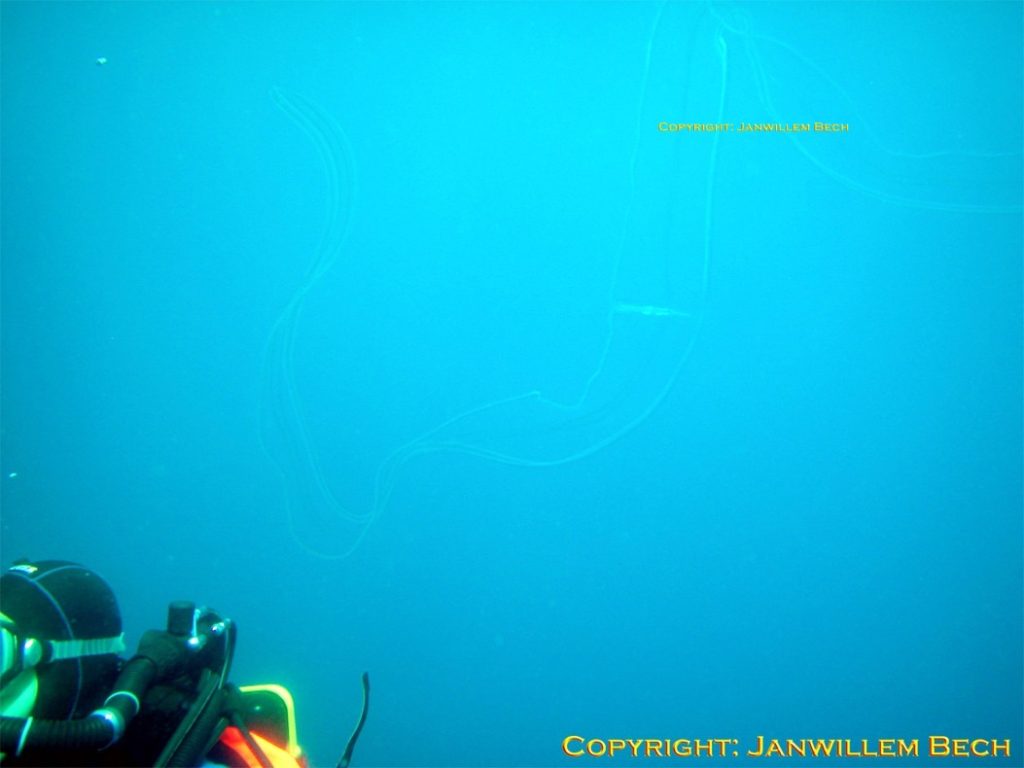
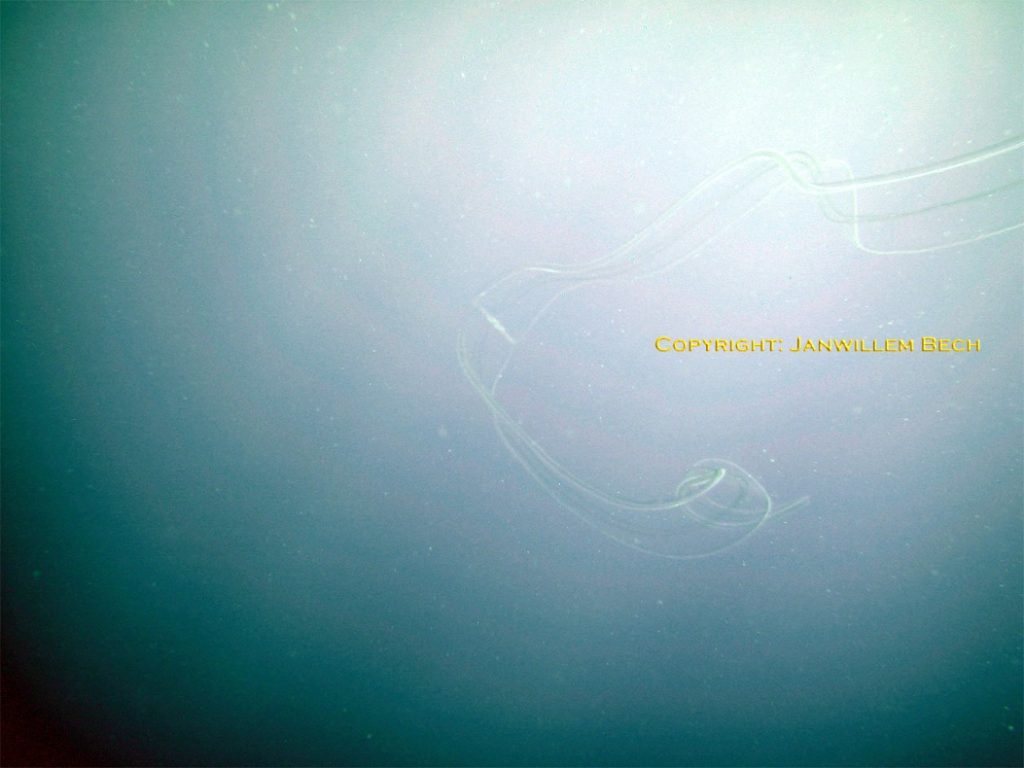
Now knowing a name I contacted Dave and Debra Wrobel of http://jellieszone.com/ and they answered me:
It appears to be a comb jelly known as the Venus’ girdle (Cestum veneris), http://jellieszone.com/cestum.htm .
They’re impressive creatures and rarely encountered – I’ve only seen one or two in years of diving.Dave Wrobel
On Dave’s web there is a description of the animal:
Consider yourself fortunate if you encounter this impressive comb jelly in California waters. A cosmopolitan inhabitant of tropical and sub-tropical seas, the Venus’ girdle is an infrequent visitor in surface waters as far north as Monterey Bay. With its ribbon-like shape and length up to 1.5 meters (although usually not exceeding 80 cm) , it’s hard to mistake with any other comb jelly, with the exception of its far smaller relative, Velamen parallelum. Cestum is generally transparent, but may have a violet color and yellow pigment on the tentacles, canals and near the tips. Gonads form a continuous line along the length of the body, unlike those of Velamen, which have a broken appearance. Tentacles are attached to a groove that runs along the oral edge, which is positioned forward as the comb jelly swims. The tentacles trail back over the body during normal swimming motion. Copepods and other small zooplankton prey are captured by the tentacles and transported to the mouth which lies at the center of the leading edge. The comb rows are on the aboral edge of the body, opposite the tentacles and mouth. When disturbed, Cestum has an escape response that consists of rapid undulation in a direction perpendicular to the direction of normal swimming. It can appear worm-like when using this response. The tissue is very delicate and easily broken apart by disturbance from a diver or during an attempt at collection.
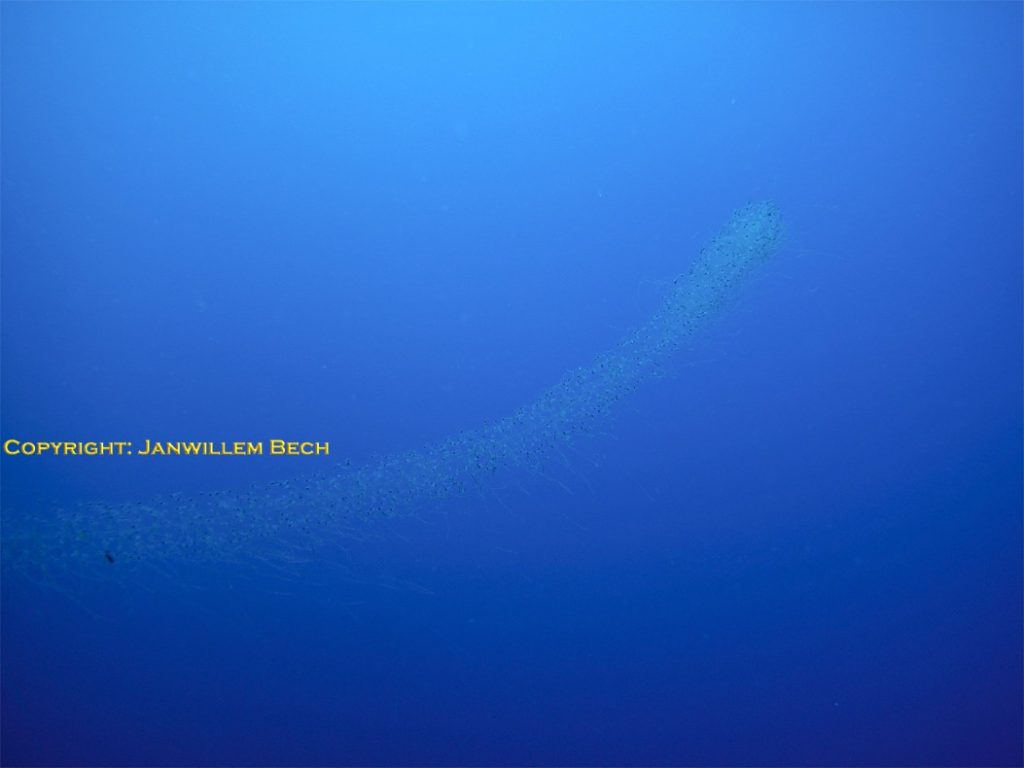
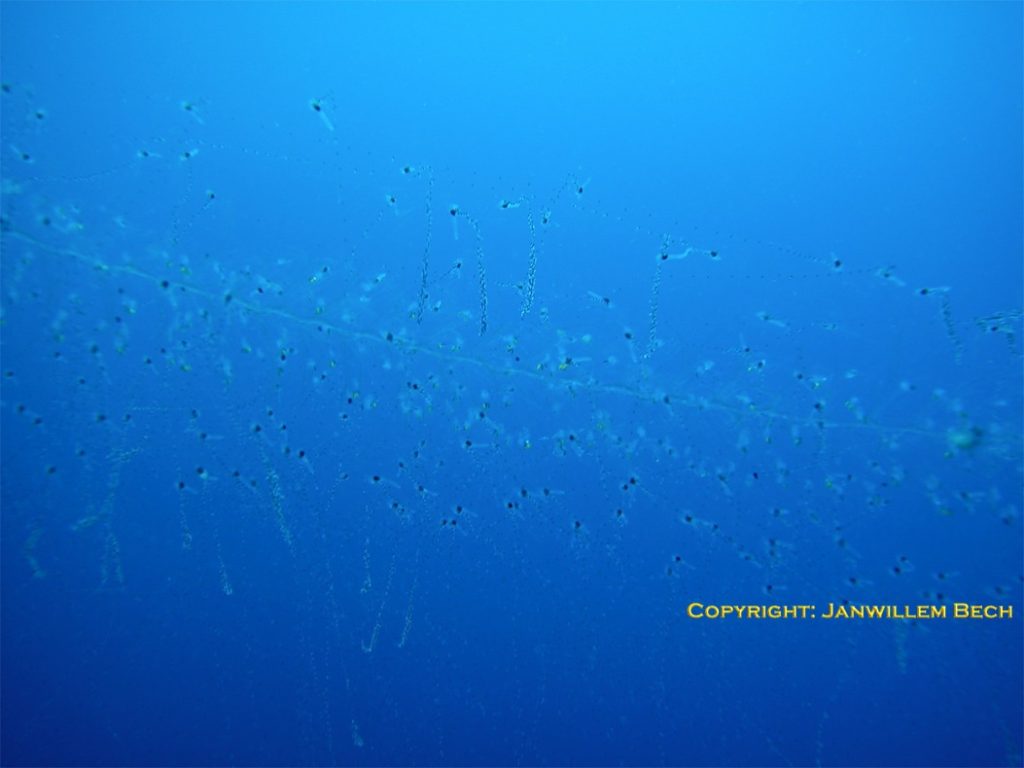
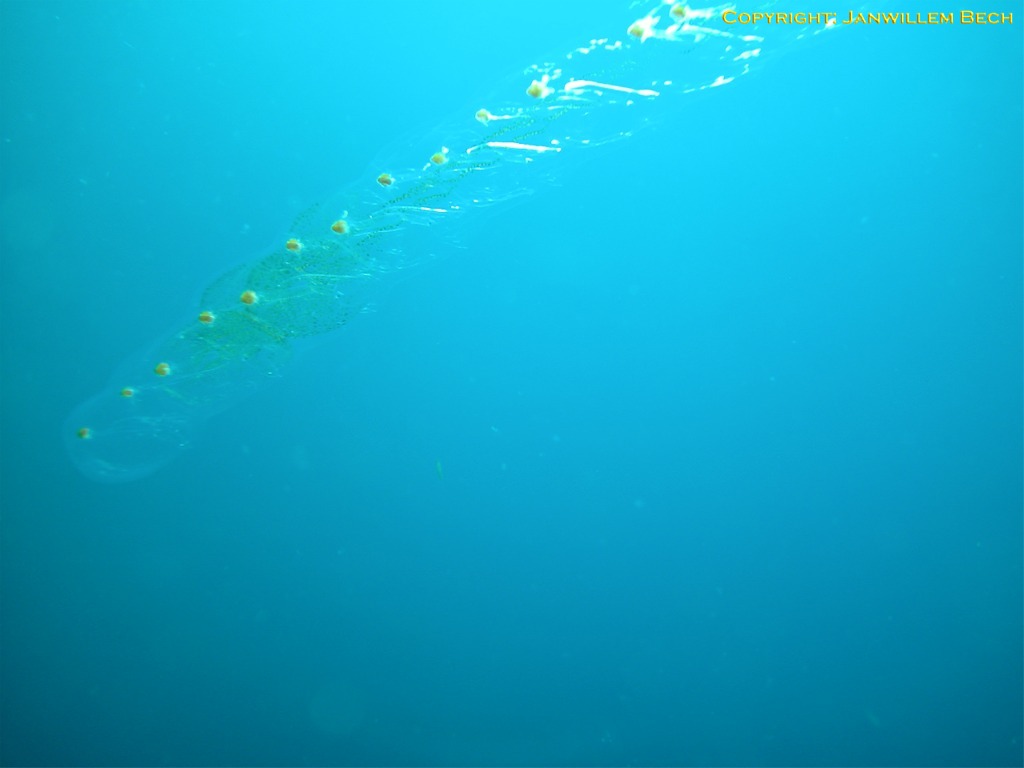
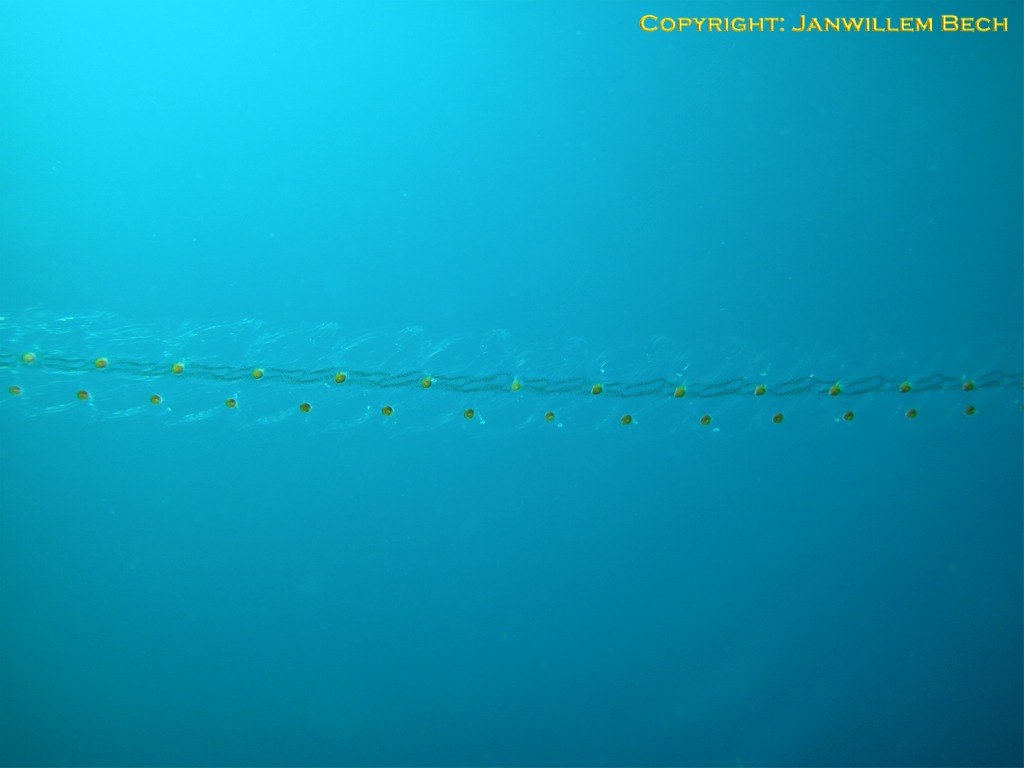
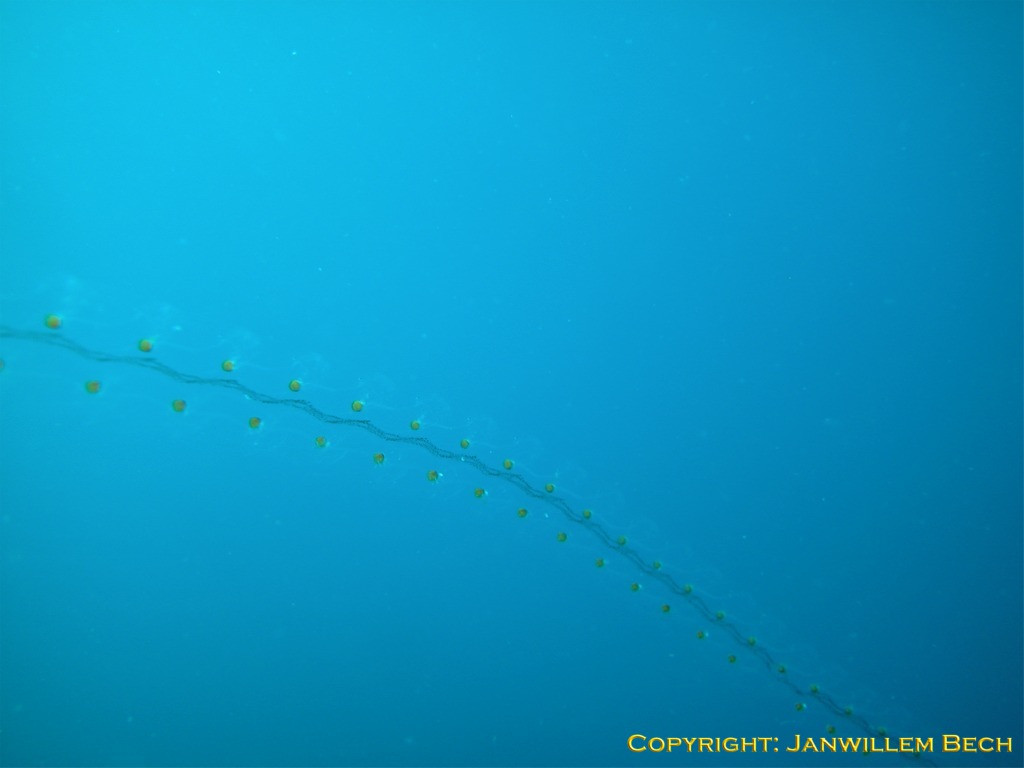
Dave and Debra Wrobel of http://jellieszone.com/ wrote:
Animal 3 is definitely a salp, although probably not Thalia democratica.

Therebreathersite was founded by Jan Willem Bech in 1999. After a diving career of many years, he decided to start technical diving in 1999. He immediately noticed that at that time there was almost no website that contained the history of closed breathing systems. The start for the website led to a huge collection that offered about 1,300 pages of information until 2019. In 2019, a fresh start was made with the website now freely available online for everyone. Therebreathersite is a source of information for divers, researchers, technicians and students. I hope you enjoy browsing the content!

















































































































































































































































































